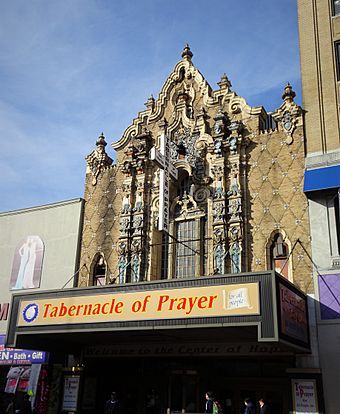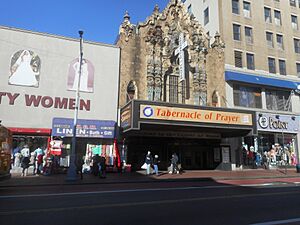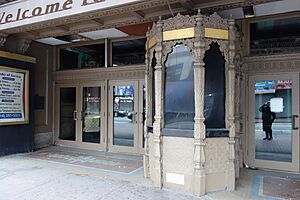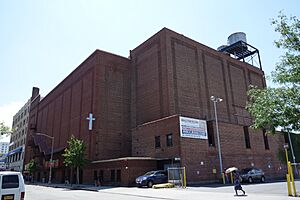Valencia Theatre facts for kids

The theater's marquee seen in 2016
|
|
| Full name | Tabernacle of Prayer |
|---|---|
| Former names | Loew's Valencia Theatre |
| Address | 165-11 Jamaica Avenue Jamaica, New York United States |
| Coordinates | 40°42′22″N 73°47′41″W / 40.70611°N 73.79472°W |
| Type | Church and movie palace |
| Capacity | 3,500 |
| Construction | |
| Built | June–December 1928 |
| Opened | January 12, 1929 |
| Architect | John Eberson |
| General contractor | Thompson–Starrett Company |
| Designated | May 25, 1999 |
| Reference no. | 2036 |
The Valencia Theatre, once known as Loew's Valencia Theatre, is a historic building in the Jamaica neighborhood of Queens, New York City. It was designed by architect John Eberson as a grand movie palace. The theater opened on January 12, 1929, as one of five famous "Wonder Theatres" built by the Loew's company in the New York City area.
Since 1977, the building has been home to the Tabernacle of Prayer for All People church. Because of its beautiful and historic design, it is a protected New York City designated landmark.
The theater has a stunning design inspired by Spanish and Mexican styles. The lobby is decorated with colorful tiles and detailed carvings. The main auditorium, which could seat 3,500 people, was designed to look like an outdoor garden at night. It had a dark blue ceiling with twinkling stars and even a machine that created fake clouds.
For many years, the Valencia was a popular spot for watching movies and live shows. After World War II, fewer people went to the movies, and the theater closed in 1977. The Tabernacle of Prayer then bought the building and carefully restored it, turning it into a place of worship while preserving its amazing architecture.
Contents
Design and Architecture
The Valencia Theatre is located at 165-11 Jamaica Avenue in Queens. It was designed by John Eberson, who was famous for creating "atmospheric theaters." These theaters were designed to make you feel like you were in a special place, like an outdoor courtyard or a garden.
The Valencia was one of five "Wonder Theatres" built by Loew's. The others were in Jersey City, Manhattan, the Bronx, and Brooklyn. The Valencia and the Paradise Theatre in the Bronx were both designed to look like Spanish courtyards.
The Building's Exterior
The outside of the theater, called the facade, is made of brick and terracotta (a type of clay). It has fancy decorations in a Spanish and Mexican style. The entrance has glass doors and a small, eight-sided ticket booth. Above the entrance is a large sign called a marquee, which used to light up with the name "Loew's Valencia."
The upper part of the building is decorated with yellow bricks and terracotta details, including small carved heads of cherubs. The windows are tall and narrow, like those in old churches. The very top of the building has a curved wall with decorative peaks called finials.
A Look Inside the Theater
The inside of the Valencia is just as impressive as the outside. The decorations use colors like gold, ruby red, and turquoise blue. The lobby is large with a high ceiling, and it once had Spanish pottery and a fountain.
The Grand Auditorium
The auditorium, where the audience sits, was designed to feel like a Spanish garden at night. It could hold about 3,500 people. The walls are decorated to look like the outside of old Spanish buildings, with fake windows, balconies, and small towers.
The ceiling is painted dark blue to look like the night sky, and it originally had tiny lights that looked like stars. A special machine even projected moving clouds across the ceiling, but it broke down in the 1970s.
Like the other Wonder Theatres, the Valencia had a special "Wonder Morton" pipe organ. This huge instrument was used to play music for silent films. The organ was removed in the 1960s and is now in the Balboa Theatre in San Diego.
History of the Valencia Theatre
In the 1920s, large, fancy movie theaters called movie palaces became very popular. Before this, most big theaters were in Midtown Manhattan. But soon, beautiful theaters started opening in other parts of New York City. The Loew's company built five of these "Wonder Theatres" to compete with another company, Paramount-Publix.
Building a Wonder Theatre
The land for the Valencia was bought in 1926. At first, the Paramount company planned to build a theater there. But in 1927, they gave the project to Loew's. Construction started in June 1928 and was led by architect John Eberson. His son, Drew, helped design the starry ceiling by copying a map of the stars from National Geographic magazine.
The theater was named "Valencia" after a city in Spain, which sounded exciting and exotic. It was planned to be the largest movie theater on Long Island.
The Valencia opened on January 12, 1929. It was the first of the five Wonder Theatres to be finished. The first movie shown was White Shadows in the South Seas, and there were also live vaudeville performances on stage. On its opening day, 17,000 people came to see the new theater.
The Golden Age of the Valencia
The Valencia quickly became a major attraction. It was one of the most important theaters in Queens. For a while, it was the only theater in the area allowed to show the first run of new movies. This meant that if you wanted to see a new film, you had to go to the Valencia.
The theater hosted both movies and live shows. Famous performers like Ginger Rogers and Kate Smith appeared on its stage. However, by 1935, Loew's decided to stop the live shows and focus only on movies. Even without the live acts, the theater remained very popular, especially on weekends.
Decline and Closure
After World War II, television became popular, and fewer people went to movie theaters. Big, expensive theaters like the Valencia began to struggle. By the 1960s, the theater was not as busy as it used to be. The cloud machine on the ceiling broke and was never fixed. The backstage area, once used for live shows, was turned into a storage space.
In 1976, the city considered making the Valencia a landmark to protect it, but Loew's was against the idea. On June 15, 1977, the Valencia Theatre closed for good. The company said it was too expensive to run and there weren't enough people coming to see movies.
A New Life as a Church
Just one month after it closed, Loew's donated the building to the Tabernacle of Prayer, a church from Brooklyn. The church paid only a very small fee for the building. The pastor, Johnnie Washington, called the theater "a gift from God."
The church spent about $250,000 to clean and restore the building. They fixed the plaster, repainted the walls, and turned the old projection room into a prayer tower. They also added a large chandelier from Greece to the auditorium. The church moved into the building in October 1977.
In 1998, the church asked the city to make the theater a landmark. On May 25, 1999, the outside of the Valencia Theatre was officially named a New York City designated landmark. This means it is protected and cannot be changed without permission. The inside was not included because the city does not usually make the interiors of religious buildings landmarks.
Today, the Valencia Theatre continues to be the home of the Tabernacle of Prayer. The building is still admired for its incredible architecture and history.
Why the Valencia Is Important
When it was built, the Valencia was praised as one of the most beautiful new buildings in Queens. Newspapers called its design "almost beyond description." Even after it declined as a movie theater, people still admired its beauty. The New York Times called it "a fading memory of what movie houses were all about."
Architectural experts have also praised the building. The writer Robert A. M. Stern called it one of Eberson's more modest but still impressive designs. The theater's amazing Spanish-style decorations continue to impress visitors today.
The Valencia's history has been celebrated in museum exhibits, including one at the Museum of the Moving Image. Its legacy lives on as a stunning example of the golden age of movie palaces and as a cherished landmark in Queens.
See also
 In Spanish: Teatro Loew's Valencia para niños
In Spanish: Teatro Loew's Valencia para niños





